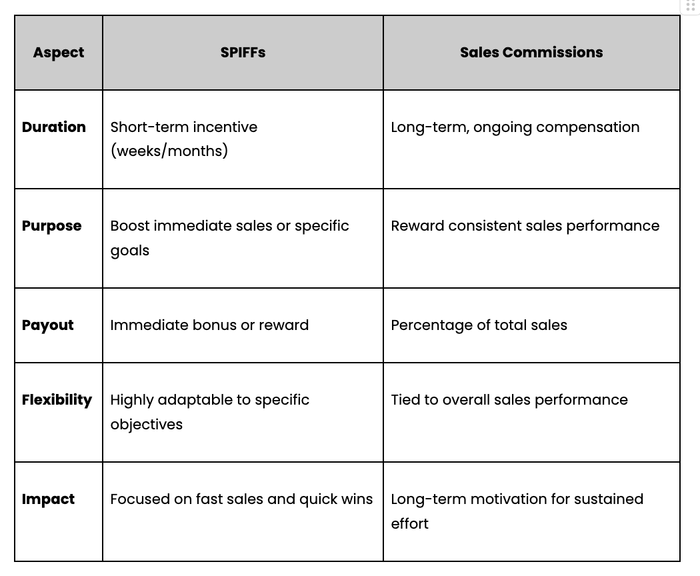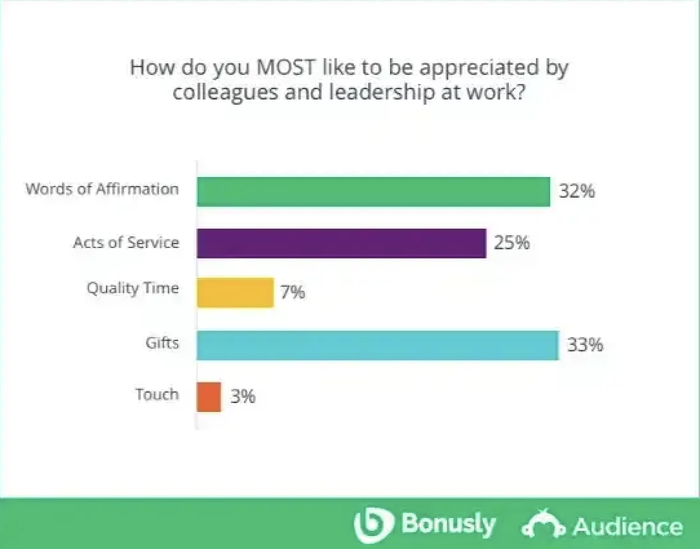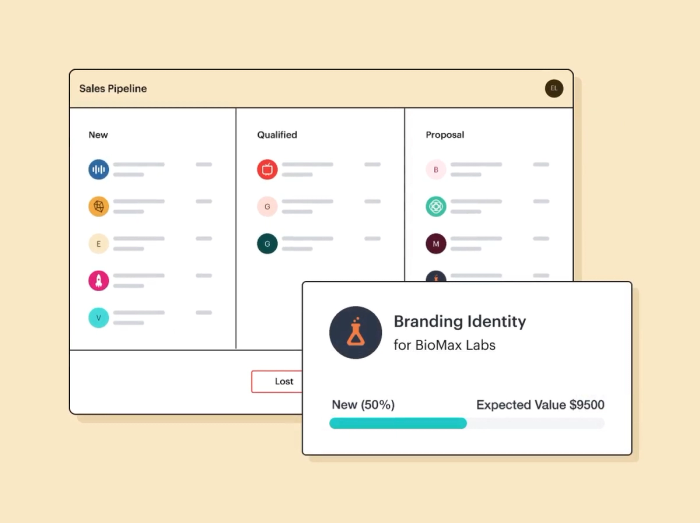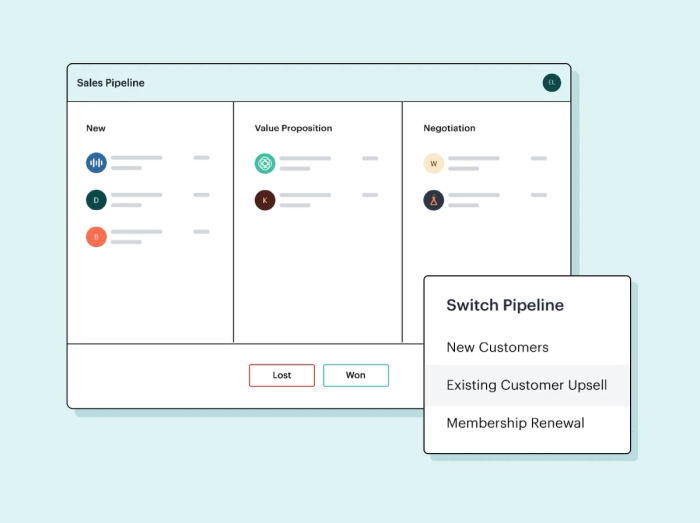Sales targets slipping? Motivation drying up?
Many sales teams are all too familiar with the feeling of hitting a wall.
When hitting sales quotas becomes challenging, and salespeople need more than promises, you need something that sparks action now – something that goes beyond the usual.
What if there was a tool that could push performance, boost morale, and drive quick wins? What is it? Stick around, and we’ll show you how one often-overlooked incentive can work magic.
What is a SPIFF?
A Sales Performance Incentive Fund (SPIFF), sometimes written as SPIF or SPIV, is a short-term incentive designed to boost specific sales behaviors.

Unlike long-term sales commission plans, SPIFFs offer immediate bonuses to sales reps for achieving targeted objectives, whether it's clearing out old inventory or promoting a particular product. These incentives can be cash bonuses or non-cash rewards, giving sales professionals the push they need to meet sales goals fast.
The term ‘spiff’ dates back to the 19th century, originally referring to a percentage allowed to young men for selling undesirable stock. According to the Oxford English Dictionary, spiffs were used to motivate sales of items that needed extra effort to move. Today, SPIFFs still serve the same purpose: driving sales teams to close deals quickly and efficiently.
When do sales leaders use SPIF?
For immediate motivation
SPIFFs can help increase motivation within your sales team. When quick action is needed, such as filling pipeline gaps, offering a sales spiff motivates sales reps to focus on hitting their goals fast.
These special incentives give each salesperson a clear reason to stay driven and deliver immediate results.
To address slow sales periods
What happens when traditional incentives don’t work in slow periods? Keeping the sales team motivated during off-seasons or sales slumps is not a walk in the park. Short-term incentives like sales spiffs bring a much-needed energy boost during these slower periods. Programs tailored to specific goals keep sales reps focused, allowing them to make up for lost revenue when sales start to decline.
For new product launches
Think of SPIFFs as a turbo boost for product launches. Launching a new offering is easier when the sales team has a clear incentive to push harder. Giving a spiff in sales tied to the new product motivates reps to prioritize it. The right SPIFFs drive early adoption and ensure sales reps do their best to promote the latest offerings.
For competitive edge
Well-structured sales spiffs often fuel healthy competition within the sales team and encourage reps to outperform one another. Offering rewards for the top performers creates a competitive atmosphere where each salesperson knows what's required to stand out.
Programs that provide clear rewards can inspire individual performance and drive collective success.
Comparison: sales performance incentive funds vs sales commissions

Types of SPIFFs
Cash SPIFFs
Cash SPIFFs directly boost sales by offering sales reps a financial reward for hitting specific sales goals.
With cash bonuses, sales teams can focus on achieving final sales for a specific product. When companies offer SPIFFs as cash incentives, the effect on sales performance can be immediate and drive maximum impact for the target business.
Some common examples of cash SPIFFs include:
- $500 bonus for exceeding a monthly sales quota.
- $100 for every upsell of a specific product.
- A specific price incentive for closing deals above a certain amount.
- Extra commission on final sales of specific products.
- Tiered cash rewards for meeting sales spiffs milestones.
These sales performance incentives can make a big difference in helping salespeople stay motivated and deliver fast results.
Non-Cash SPIFFs
Non-cash SPIFFs work by offering alternatives to financial rewards. These incentives are effective when cash isn’t the only motivator. Non-cash incentives break the monotony and can help you create lasting engagement for sales teams.
Examples of non-cash SPIFFs:
- Recognition-based SPIFFs include awards, leaderboards, and exclusive clubs.
- Power-based SPIFFs allow top sales reps to choose accounts or attend customized training.
- Gift-based SPIFFs consist of tech gadgets or branded merchandise.
They all provide a tangible reward that stays with the sales rep long after the incentive is earned. Gifts and words of affirmation are among the most valued forms of appreciation in the workplace, with a huge portion of employees preferring these methods:

These strategies provide maximum impact by building a culture where sales teams are more likely to buy in – without overextending the budget.
Designing an effective SPIFF program: A 7-step process
Step 1: Set clear objectives
Successful SPIFF programs start with transparent objectives since a clear goal can guide the right approach.
Some examples:
- Increase sales of the latest product line by 20% within the next quarter.
- Generate at least 30 new product demos per week to drive pipeline growth.
- Raise the average order value by 15% through add-on sales and upselling.
- Decrease customer churn by 10% by incentivizing renewals.
Goals should focus on motivating salespeople to close deals quickly and generate more sales. Misaligned objectives can lead to confusion. The program must make sense for everyone and fit within the broader strategy.
Step 2: Select the right rewards for sales reps
Choosing the right pay incentives can make or break your SPIFF program.
As mentioned, options can include cash-based incentives, such as bonuses for hitting targets, or non-cash rewards, such as recognition and experiences. You have to understand what really drives your team.
Cash often works best for immediate results, but non-monetary rewards can effectively engage your salespeople in the long run, especially in challenging work environments.
Step 3: Define eligibility and timeframe
Establish who qualifies for the SPIFF program and define the term SPIFF clearly.
You don’t have to offer the program company-wide. Limiting eligibility to the right teams or individuals keeps the program impactful. On top of that, a start and end date gives reps a sense of urgency, motivating them to get results quickly. Without a clear timeframe, sales efforts can lose momentum.
Step 4: Track and communicate progress in your sales team
Tracking a spiff program is more than just checking numbers. With Capsule CRM, your team gets real-time updates on every deal. Salespeople can see where they stand and what’s next to hit their SPIFF targets.
Capsule’s visual pipeline keeps everyone on the same page – drag, drop, and close. It's that simple.

Capsule shows the full picture: which deals are moving, which ones are stuck, and how fast they’re closing. Your salesperson is dialed in, knowing when to push harder or follow up.
With real-time insights and reporting, there’s no need for endless sales meetings, and the team stays in the loop.

Do you need flexibility? Capsule lets you build custom pipelines and track different activities so your SPIFF strategy can adapt on the go.
Step 5: Keep your sales performance incentive fund simple and transparent
A spiff is stronger when its rules are simple and transparent. Avoid overcomplicating the SPIFF with too many conditions or restrictions. Make sure the word spiff is simple enough for all your salespeople to understand:
- how to participate,
- which products or services are eligible,
- how their performance will be tracked,
- what the rewards are,
- and how to achieve them.
Certain elements can overcomplicate these programs, but keeping things simple leads to higher participation and more successful sales efforts.
Step 6: Monitor for pitfalls and adjust as needed
Common pitfalls, such as sales sandbagging or burnout from overuse, can derail a spiff program if not properly managed.
Sales sandbagging occurs when sales reps intentionally delay closing deals to qualify for a soon-to-launch SPIFF. This practice distorts performance metrics and undermines the incentive's true purpose.
Burnout from overuse refers to the diminishing motivational power of SPIFFs when they are used too frequently. If SPIFFs become a constant expectation, they lose their impact, and reps may become disengaged because the rewards no longer feel special.
Address these issues by making adjustments as needed. Keep the program flexible and limit the frequency of SPIFFs to prevent overreliance on short-term incentives. Continuously monitoring the program helps you spot potential problems early – allowing you to create successful, goal-oriented programs.
Step 7: Measure success and refine
After completing the SPIFF, measure its success using these four metrics:
- SPIFF achievement rate: The percentage of salespeople who hit the target.
- Sales velocity: How quickly deals closed during the SPIFF.
- Revenue generated: Compare the revenue boost against the pay incentive cost.
- Rep engagement: Evaluate how well the SPIFF motivated the team to increase sales.
A thorough post-spiff review provides insights into what worked and what didn’t. Continuous refinement of the SPIFF program ensures even better results in the future.
Over to you
A spiff program isn’t some magic potion that will solve all your sales challenges overnight. It can definitely spark the right behaviors when used thoughtfully, though.
It’s all about focusing on clear, measurable goals and offering rewards that matter to your team.
Overcomplicate the process, and you’ll lose momentum.
Keep it straightforward, and you’ll see faster, sharper results.
SPIFFs work best when they’re constantly refined. Adjust them based on what’s working and keep the incentives relevant to maintain excitement. Done right, a spiff program turns short-term incentives into long-term gains. Good luck!




